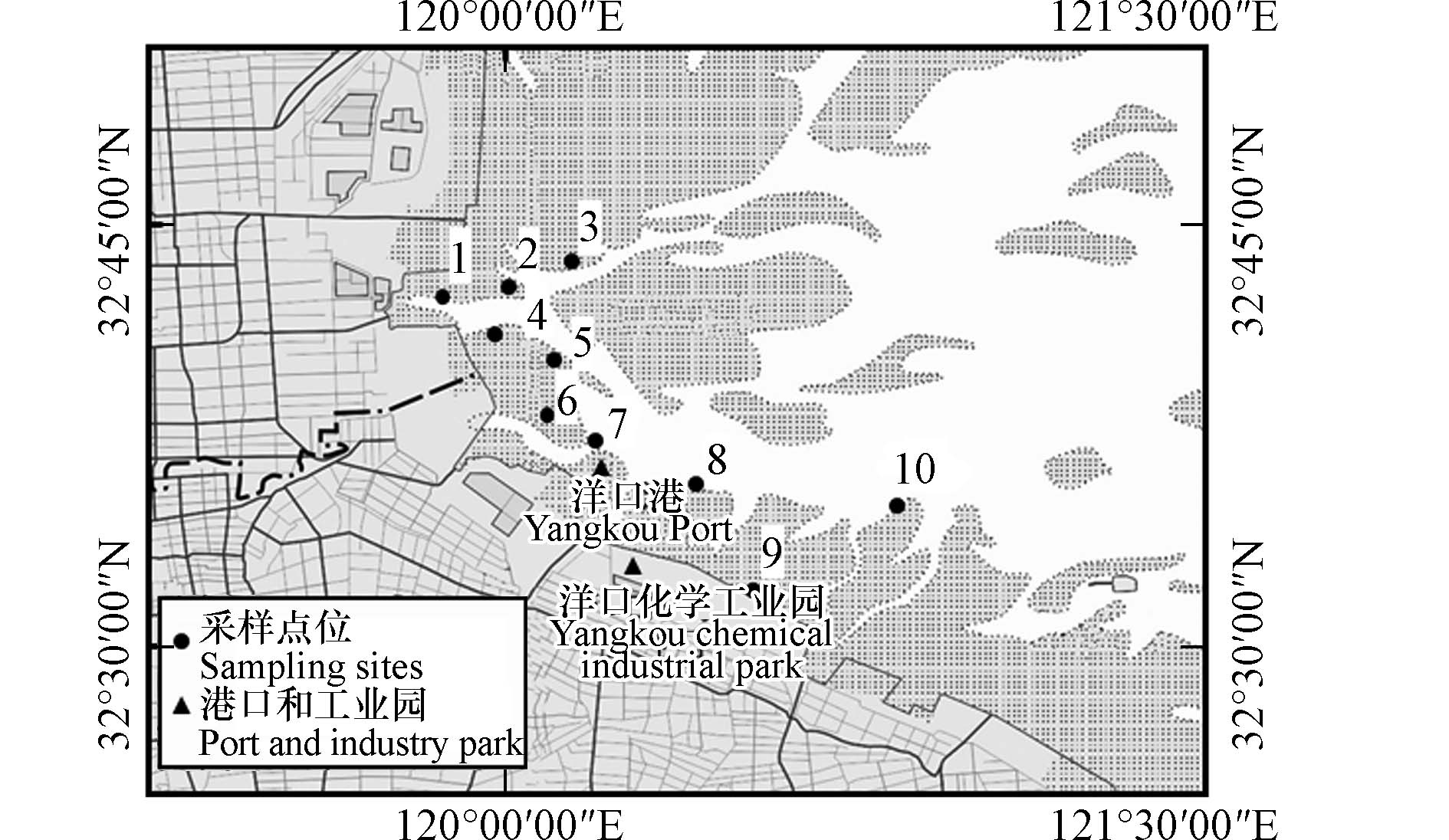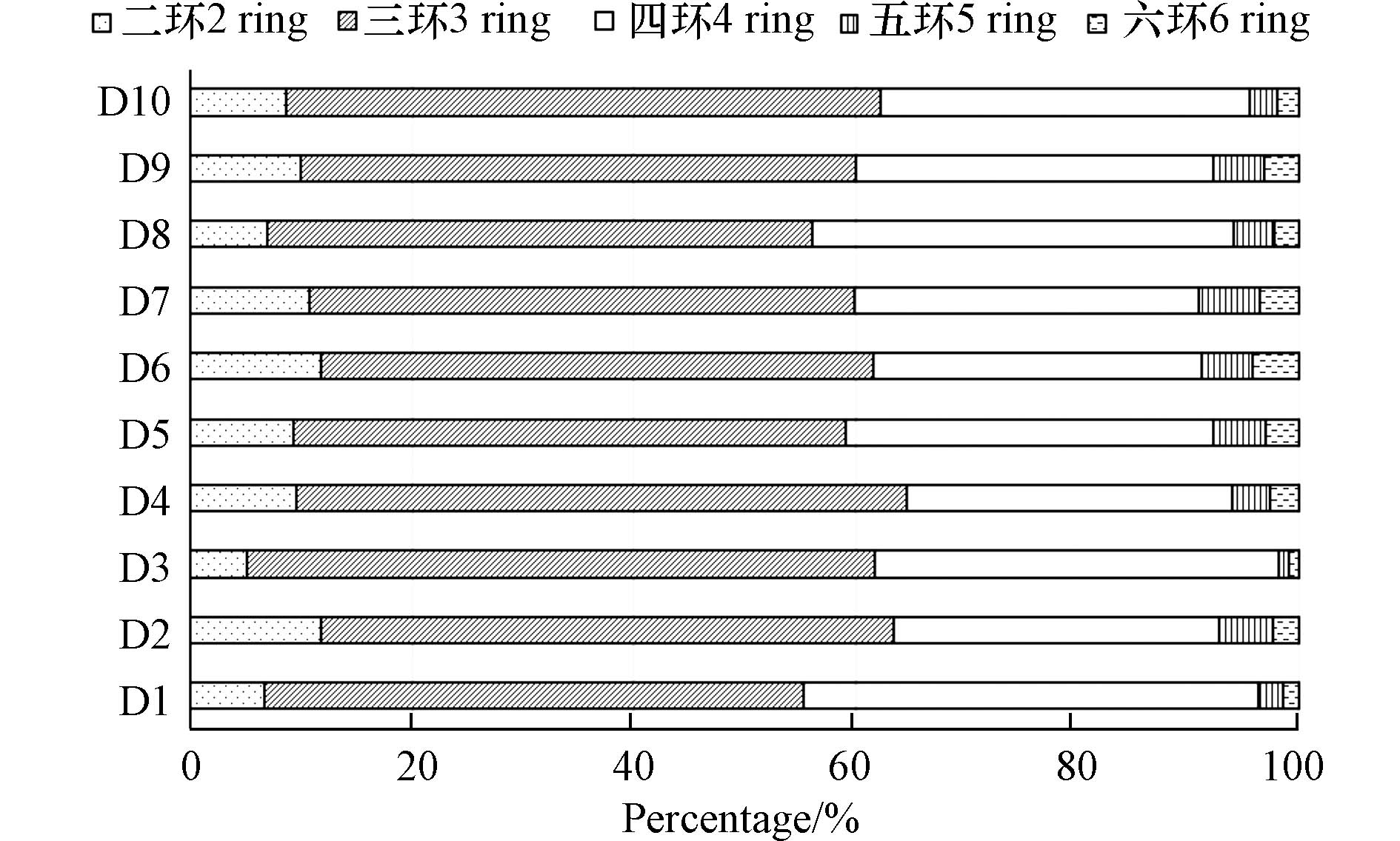-
石油烃主要包括正构烷烃、异构烷烃、环烷烃、芳香烃以及树脂和沥青等,石油污染在不同程度上影响了海洋微生物、植物和动物的生长繁殖[1]. 海洋环境中的石油烃主要来源于成岩转化、生物合成、工业民用废水排放、港口和船舶作业含油污水排放以及燃油泄漏等突发污染事故[2-3]. 研究正构烷烃的分布特征,对正构烷烃多种特征指数进行综合评价,是国内外广泛采用的海洋沉积物石油烃来源分析方法[2,4]. 多环芳烃是石油烃的重要组成成分,是具有致癌、至畸、致突变作用的持久性有机污染物,多环芳烃在海洋生物体内不断富集并通过食物链传递与放大进入人体,最终威胁人体健康[5]. 海洋环境中的多环芳烃很少部分来自自然源,大部分来自生物质和化石燃料不完全燃烧或石油泄漏等人为源[6].
海洋沉积物是环境中石油烃等多种有机污染物的主要归宿,近岸海洋沉积物中石油烃赋存状况受沿海地区生产活动的影响较为显著. 江苏小洋口地区位于我国中部江淮下游,濒临南黄海,研究区域内建有洋口化学工业园和LNG码头,存在较为密集的沿海化工生产和航运活动. 近年来对南黄海的溶解氧分布、浮游动物群落特征以及沉积物中有机质来源等已有较多的分析和研究[7-9],但对南黄海近岸海域沉积物中石油烃类污染物的研究较少. 本研究对小洋口地区近岸海域表层沉积物中石油烃总量和多环芳烃含量进行了分析,研究了正构烷烃分布特征并探讨了石油烃来源,为掌握该地区的污染状况提供基础数据.
-
于2020年5月采集了江苏如东小洋口近岸海域共10个点位的表层沉积物,点位分布见图1. 为使监测范围能够反映近岸生产活动对该地区海洋环境的影响,采样区域包含河口地区以及港口、化学工业园等建设项目. 按照《海洋监测规范》(GB 17378.5-2007)[10]要求,在每个点位上,利用抓斗式采泥器采集适量表层(0—20 cm)沉积物样品,装入棕色玻璃瓶中低温冷藏,运回实验室进行后续分析.
-
加速溶剂萃取仪:美国戴安,ASE 200;气相色谱仪:安捷伦,7809B;气相色谱-质谱联用仪:安捷伦,7890B-5973C;氮吹浓缩仪:美国Organomation Associates,N-EVAP 111;固相萃取(SPE)小柱:美国Supelco Florisil,1g/6 mL;旋转蒸发仪:德国 Heidolph, Laborota 4000 efficient.
正己烷:J.T.Baker,农残级;二氯甲烷:J.T.Baker,农残级;硅藻土:0.02—0.10 mm;无水硫酸钠:450 °C下灼烧4 h,冷却后使用. 正己烷中C8-C40正构烷烃包含姥鲛烷、植烷:美国Accustandard,单组分浓度为500 μg·mL−1;16种多环芳烃标准溶液:美国Accustandard,单组分浓度为200 μg·mL−1。
正己烷中7种氘代多环芳烃混合标准溶液(萘-D8、苊-D8、菲-D10、荧蒽-D10、芘-D10、苯并[a]芘-D12和苯并[g,h,i]苝-D12):Cambridge公司,10 μg·mL−1;正己烷中六氯苯-13C6和苯并[a]蒽-D12,Cambridge公司,20 μg·mL−1.
-
采集的沉积物样品冷冻干燥并研磨至100目以下,样品称取量为5.00 g.
-
样品采用加速溶剂萃取法(ASE)进行提取.
石油烃检测:称取沉积物样品,加入硅藻土4.00 g,充分混匀转移至22 mL萃取池中,加入无水硫酸钠1 g. 提取剂正己烷,萃取温度100 °C,压力1500 psi,循环2次,静态萃取时间15 min,氮气吹扫60 s,溶剂淋洗体积60%.
多环芳烃检测:称取沉积物样品,加入硅藻土4.00 g,充分混匀转移至22 mL萃取池中,加入无水硫酸钠1 g以及净化内标(7种氘代多环芳烃). 萃取溶剂为二氯甲烷和正己烷(1:1,V/V),萃取温度150 ℃,压力1500 psi,循环2次,静态萃取时间8 min,氮气吹扫45 s;溶剂淋洗体积70%.
-
石油烃检测:将萃取液采用旋转蒸发仪浓缩至1 mL,净化柱依次用10 mL正己烷-二氯甲烷(1:1,V/V)混合溶液、10 mL正己烷活化后,将浓缩液转移至SPE小柱净化,收集流出液,用2 mL正己烷洗涤浓缩液收集装置,用12 mL正己烷淋洗净化柱,合并收集淋洗液和流出液,采用氮吹仪浓缩至1 mL.
多环芳烃检测:将萃取液采用旋转蒸发仪浓缩至1 mL,净化柱依次用5 mL二氯甲烷和10 mL正己烷活化后,将浓缩液转移至SPE小柱净化,收集流出液,用3 mL正己烷洗涤浓缩液收集装置,用10 mL洗脱液(正己烷:二氯甲烷=7:3,V/V)淋洗净化柱,合并收集淋洗液和流出液,采用氮吹仪浓缩至0.5 mL,加入进样内标(六氯苯-13C6和苯并[a]蒽-D12)并定容至1 mL.
-
总石油烃和正构烷烃(GC-FID) 色谱柱:HP-5(30 m×0.32 mm×0.25 μm),升温程序:初始温度50 °C,保持3 min,10 °C·min−1升温至140 °C,保持5 min,20 °C·min−1升温至320 °C,保持10.5 min;进样口温度:300 °C;柱流量:1.5 mL·min−1;不分流进样;进样体积1 μL;FID检测器温度325 °C;氢气流量:30 mL·min−1,空气流量:300 mL·min−1. 正构烷烃(C10—C40)及姥鲛烷、植烷气相色谱图见图2,按照出峰时间由前到后依次为C10—C17、姥鲛烷、C18、植烷、C19—C40.
多环芳烃(GC-MS) 色谱柱:HP-5(30 m×0.32 mm×0.25 μm),升温程序:初始温度80 °C,保持1 min,20 °C·min−1升温至250 °C,保持5 min,3.5 °C·min−1升温至290 °C,保持3 min;进样口温度:310 °C;柱流量:1 mL·min−1;不分流进样;进样体积1 μL;电子轰击离子源,电子能量70 eV;离子源温度:230 °C;传输线温度:280 °C;溶剂延迟:4 min;选择离子监测模式(SIM),特征离子参考《土壤和沉积物 多环芳烃的测定 气相色谱质谱法》(HJ 805-2016)[11].
-
石油烃总量根据石油烃(C10—C40)保留时间窗进行定性,从正癸烷出峰开始,到正四十烷结束连接一条水平基线进行积分(扣除柱流失的面积),计算定性时间窗口内总峰面积,采用外标法定量. 单组分正构烷烃含量根据保留时间定性,采用外标法定量. 多环芳烃含量根据保留时间和特征离子定性,采用内标法定量.
-
正构烷烃(C10—C40)、姥鲛烷、植烷单组分分析标准曲线线性范围为0—50 μg·mL−1,相关系数>0.9999. 石油烃总含量分析标准曲线线性范围为0—1.55 mg·mL−1,相关系数>0.9999. 单组分多环芳烃含量分析标准曲线线性范围为0—5.00 μg·mL−1, 相关系数>0.999. 每瓶沉积物样品设置2组平行实验,每次检测设置空白实验. 正构烷烃空白加标实验单组分加标浓度为10 μg·g−1时,平均回收率为80%. 多环芳烃空白加标实验单组分加标浓度为100 ng·g−1时,平均回收率为81%.
-
本研究在分析石油烃总量的基础上,计算能够反映烃类组成和分布特征的多种指数,综合分析研究海域的石油污染情况和石油烃来源. 其中,正构烷烃(n-Alkane)的碳数范围、主峰碳数、奇偶优势、碳优势指数等能够帮助指示沉积物中石油烃类物质来源,包括陆源、海源、石油污染等重要信息. 姥鲛烷与植烷的相对含量以及同正构烷烃的含量比值能够反映沉积物的沉积环境以及石油烃的降解程度,复杂混合物(UCM)的含量与分布与石油污染、微生物降解等因素有关[12-13].
研究采用的具体指数含义及计算方法见表1.
-
对石油烃总量(TPH)进行了计算,计算结果见表2. 研究海域各点位石油烃总量范围为3.95—13.28 μg·g−1,平均值为7.59 μg·g−1. 正构烷烃碳数组成范围为C11—C36,其中5号点位呈现陆源输入优势型单峰群分布,其余点位呈现陆、海混合来源的双峰群分布[14-15]. 典型分布图见图3.
本研究将小洋口海域表层沉积物中TPH的浓度与国内部分海域研究结果进行比较,如表3所示,小洋口海域表层沉积物中TPH浓度水平相对较低,明显低于长江口和珠江口等海域的研究结果.
根据联合国环境规划署认定未受污染的沉积物中烃类物质的浓度不超过10 μg·g−1[18],本研究的1号点位和5号点位所在海域可能受到了一定程度的石油污染. 距离河口位置较近的1号和2号点位TPH浓度相对较高,可能受河流输送影响较大. 距离洋口港和洋口化工园区较近7—10号点位TPH浓度相对较低,表明该海域近岸港口和化工生产未对邻近海域沉积物中石油烃浓度产生明显影响.
-
本研究对正构烷烃相关的多种指数进行了统计计算,结果见表4. 其中L/H<1表明正构烷烃主要来源是高等植物、海洋动物与细菌,L/H接近1表明正构烷烃来源于浮游生物和石油,L/H>2通常认为有新的石油污染[12,19]. 结果显示本项目研究海域大部分采集点位L/H接近于1,各点位L/H均值为0.83,表明大部分点位石油烃来源为浮游生物和石油. 其中5号点位L/H较小,石油烃可能主要来源于高等植物和海洋动物,受陆源物质影响相对较大.
TAR是评价正构烷烃陆源、海源相对贡献的参数. 陆源优势正构烷烃主要为C27、C29、C31,海源优势正构烷烃主要为C15、C17、C19,由于短链正构烷烃更易受微生物作用被降解,此比值可能会高估陆源贡献[13,20]. 结果显示本项目研究海域各点位TAR均大于1,均值为4.82,表现出一定的陆源优势,尤其是5号点位.
CPI是区分正构烷烃来源的另一个常用指标,陆源高等植物正构烷烃奇偶优势明显,CPI值一般为4—10,细菌的作用或者石油及其产品来源的正构烷烃一般无明显奇偶优势,CPI接近于1[17,21]. 本项目研究海域各点位短链烷烃碳优势指数CPI1范围为0.15—0.61,均值为0.37,有一定的偶数碳优势,可能受到石油污染、细菌合成以及微生物降解作用影响. 长链烷烃碳优势指数CPI2范围为0.86—2.37,均值为1.54,接近于1,陆源优势不明显,可能是混合来源的结果.
C16在未受石油污染的海域中较少出现. 通常Σn-Alk/C16比值可用于表征沉积物是否受到石油污染,该比值小于30表明受到了石油污染,大于50说明未受到污染[17,22]. 本项目研究海域各点位均检出了C16,除5号点外,各点Σn-Alk/C16比值均小于30,可能受到了石油污染,5号点小于50,不能说明未受到石油污染.
UCM组分是支链烷烃和环烷烃等构成的未分离复杂混合物,被广泛认为是石油及其精炼产品降解和风化的产物,有研究采用U/R来推断沉积物是否受到石油污染,U/R大于2表明受到石油产品污染,小于4表明受到了轻度石油污染,大于4则表明受到了严重的石油污染[23]. 本项目研究海域各点位U/R范围为1.24—4.33,平均值为2.33,表明整体可能受到轻度石油污染.
姥鲛烷Pr和植烷Ph的比值常用于判断沉积环境,Pr/Ph<1.0时,缺氧还原的沉积环境,而Pr/Ph>1.0时,为氧化的沉积环境[15,24]. 本文各点位样品中Pr检测结果小于检出限(4.40×10−2 μg·g−1),Ph检测结果浓度范围为(3.59—4.09)×10−2 μg·g−1,Pr的浓度按照检出限的1/2计算[25],得到Pr/Ph的范围为0.54—0.61,结果小于1,表明研究海域可能为缺氧还原的沉积环境. 由于姥鲛烷和植烷比相邻的正构烷烃更难降解,因此C18/Ph可用于表征石油降解程度. 研究海域各点位C18/Ph范围为2.06—2.75,均值为2.44,与未经风化或降解的原油或原料油中,C18/Ph比值范围(2.0—4.5)接近. 表明沉积物中石油烃尚未受到明显的降解和风化.
-
本研究针对美国环保署(EPA)优先控制的16种多环芳烃对研究海域各点位沉积物进行了分析,各点位沉积物中16种多环芳烃总量见表5. 研究海域16种多环芳烃总量范围为53.1—117.0 ng·g−1,与该海域其它研究浓度相当,在国内处于相对较低水平[24]. 各点位沉积物中16种多环芳烃均有检出,其中不同环数占比情况见图4. 由图4可知,各点位沉积物中不同环数多环芳烃占比由大到小依次为:三环>四环>二环>五环>六环,以三环和四环为主,总含量占16种多环芳烃总量的79.6%—93.0%. 有研究表明,低分子量多环芳烃(2—3环)主要来源于化石燃料中低温燃烧、成岩作用和石油污染,高分子量多环芳烃(4—6环)主要来源于化石燃料高温燃烧[26]. 根据研究海域各点位不同环数多环芳烃占比情况,研究海域沉积物中多环芳烃可能由石油污染、成岩作用、化石燃料燃烧等多种来源构成.
-
(1)江苏小洋口近岸海域表层沉积物总石油烃含量在3.95—13.28 μg·g−1之间,碳数分布为C11—C36. 正构烷烃的分布呈现陆海混合来源的双峰型分布和陆源优势的单峰型分布两种类型. 距离河口较近的点位石油烃含量相对较高,可能受河流输入影响较大. 洋口港和洋口化学工业园邻近海域沉积物中石油烃含量相对较低,港口和化工生产对邻近海域中石油烃含量未产生明显影响.
(2)L/H和TAR的比值分析结果表明,研究海域大部分表层沉积物中石油烃来源为陆海混合来源,5号点位陆源优势相对明显. 研究海域各点位短链烷烃碳优势指数CPI1范围为0.15—0.61,有一定的偶数碳优势,CPI2范围为0.86—2.37,无明显奇偶优势,可能是混合来源的结果.
(3)Σn-Alk/C16比值范围为11.4—41.4,U/R范围为1.24—4.33,表明研究海域可能受到轻度石油污染. 其中5号点位受石油污染等人为因素影响相对较小.
(4)Pr/Ph<1,表明沉积环境为缺氧环境,可能受到了石油烃污染;C18/Ph范围为2.06—2.75,与原油中比例接近,表明石油烃尚未受到明显的降解和风化.
(5)江苏小洋口近岸海域表层沉积物中16种多环芳烃总量在53.1—117.0 ng·g−1之间,在国内处于相对较低水平,以三环和四环多环芳烃为主,可能由石油污染、成岩作用、化石燃料燃烧等多种来源构成.
江苏小洋口近岸海域沉积物中石油烃类物质分布特征及来源
Distribution characteristics and sources of petroleum hydrocarbons in sediments from Xiaoyangkou coastal area in Jiangsu Province
-
摘要: 为深入了解江苏小洋口地区近岸海域表层沉积物中石油烃污染状况,分析近岸生产活动对海洋环境的影响,于2020年在小洋口近岸海域采集了10个点位的沉积物样品,采用气相色谱法和气相色谱质谱法分析测定其中的石油烃及多环芳烃总量,揭示了正构烷烃(n-Alkane)分布特征并探讨了石油烃来源. 结果表明,小洋口近岸海域表层沉积物中石油烃总量介于3.95—13.28 μg·g−1之间,碳数分布为C11—C36;洋口港、洋口化学工业园附近海域沉积物中石油烃含量相对较低,港口和化工生产项目未对邻近海域中石油烃浓度产生明显影响. 河口附近石油烃含量相对较高,可能受陆源输入影响较大. 大部分点位沉积物中石油烃为陆海混合来源,个别点位沉积物中石油烃以陆源输入为主;数据显示该海域可能受到轻度石油污染. 此外,小洋口近岸海域表层沉积物中多环芳烃总量介于53.1—117.0 ng·g−1之间,与该海域其它研究浓度相当,在国内处于相对较低水平;以三环和四环芳烃为主,可能是燃烧与石油混合来源的结果.Abstract: In order to understand the pollution status of petroleum hydrocarbons in surface sediments of Xiaoyangkou coastal area and analyze the impact of nearshore production activities on the marine environment,10 sediment samples were collected in 2020 and analyzed for the content of petroleum hydrocarbons by gas chromatography and polycyclic aromatic hydrocarbons (PAH) by gas chromatography- mass spectrometry. The distribution characteristics of n-alkane and the source of petroleum hydrocarbons were studied. The results showed that the content of total petroleum hydrocarbons (TPH) varied from 3.95 μg·g−1 to 13.28 μg·g−1, and the carbon number distribution was from 11 to 36. The content of TPH in the sediments near Yangkou Port and Yangkou Chemical Industrial Park were relatively low, which indicated that the port and chemical production projects had no obvious influence on the concentration of petroleum hydrocarbon in the adjacent sea areas. The TPH content near the river mouth was at a relatively high level, which may be greatly affected by terrigenous input. Petroleum hydrocarbons in most of the samples were from terrigenous and marine mixed sources, while terrigenous input was dominant in a small part of samples. It was possible that this area was slightly contaminated by petroleum. The total amount of PAHs ranged from 53.1—117.0 ng·g−1, which was consistent with other studies in this sea area and at a relatively low level compared with other sea areas in China. Tricyclic and tetracyclic aromatic hydrocarbons were predominant, which was probably as a result of combustion mixed with petroleum sources.
-
Key words:
- Xiaoyangkou /
- marine sediment /
- petroleum hydrocarbons /
- distribution characteristics.
-

-
表 1 研究采用指数计算方法及意义
Table 1. The calculation method and meaning of the index adopted in this study
指数名称
Index计算方法
Calculation method指数含义
Meaning$ \displaystyle\sum \text{n}-\text{Alk} $ 正构烷烃总量与正十六烷含量比值 用于评价沉积物是否受到石油污染. $ \text{L}/\text{H} $ $ \text{L}/\text{H}=\left(\displaystyle\sum {\text{C}}_{\text{23-}}\text{/}\displaystyle\sum {\text{C}}_{\text{24+}}\right) $ 用于评价正构烷烃主要来源,如高等植物、海洋动物、细菌、石油等. $ \text{TAR} $ $ \text{TAR=}\left({\text{n}\text{C}}_{\text{27}}+{\text{n}\text{C}}_{\text{29}}+{\text{n}\text{C}}_{\text{31}}\right)\text{/}\left({\text{n}\text{C}}_{\text{15}}+{\text{n}\text{C}}_{\text{17}}+{\text{n}\text{C}}_{\text{19}}\right) $ 用于评价正构烷烃陆源、海源相对贡献. $ {\text{CPI}}_{\text{1}} $ $\begin{aligned} {\text{CPI} }_{\text{1} }=&\text{1/2}\Big[\displaystyle\sum {\text{C} }_{\text{15-21} }\left(\text{奇碳}\right)\text{/}\displaystyle\sum {\text{C} }_{\text{14-20} }\left(\text{偶碳}\right)+\\ & \displaystyle\sum {\text{C} }_{\text{15-21} }\left(\text{奇碳}\right)\text{/}\displaystyle\sum {\text{C} }_{\text{16-22} }\left(\text{偶碳}\right)\Big]\end{aligned}$ 短链烷烃碳优势指数,用于区分正构烷烃来源. $ {\text{}\text{CPI}}_{\text{2}} $ $\begin{aligned} {\text{CPI}}_{\text{2}}=&\text{1/2}\Big[\displaystyle\sum {\text{C}}_{\text{25-35}}\left(\text{奇碳}\right)\text{/}\displaystyle\sum {\text{C}}_{\text{24-34}}\left(\text{偶碳}\right)+\\& \displaystyle\sum {\text{C}}_{\text{25-35}}\left(\text{奇碳}\right)\text{/}\displaystyle\sum {\text{C}}_{\text{26-36}}\left(\text{偶碳}\right)\Big] \end{aligned}$ 长链烷烃碳优势指数,用于区分正构烷烃来源. C18/Ph 正十八烷含量与植烷含量比值 用于评价石油降解程度. U/R 复杂化合物与可分离烷烃含量比值 用于推断沉积物是否受到石油污染. 表 2 研究海域各点位石油烃总量及正构烷烃总量
Table 2. The contents of total petroleum hydrocarbons and total n-alkanes at each point in the study areas
点位
Sampling points石油烃总量/(μg·g−1)
TPH正构烷烃总量/(μg·g−1)
$ \sum n-Alk $ 1 10.40 1.99 2 9.35 1.36 3 7.50 1.30 4 6.19 1.57 5 13.28 4.31 6 5.19 1.74 7 6.60 1.67 8 6.33 2.07 9 7.12 1.72 10 3.95 1.23 均值 7.59 1.90 表 3 近岸海域表层沉积物中总石油烃浓度比较
Table 3. Comparison of total petroleum hydrocarbon concentrations in surface sediments of coastal waters
表 4 研究海域正构烷烃相关指数
Table 4. The index calculated from n-alkanes in the study areas
点位
Sampling points$ \sum n-Alk $ L/H TAR CPI1 CPI2 C18/Ph U/R 1 15.3 0.73 3.40 0.44 1.34 2.52 3.19 2 12.7 0.72 5.68 0.17 1.42 2.45 4.33 3 11.4 0.79 3.99 0.19 1.18 2.18 3.46 4 13.1 0.67 6.73 0.15 1.71 2.47 2.25 5 41.4 0.23 10.8 0.43 1.14 2.39 2.04 6 15.6 1.12 2.72 0.53 1.47 2.75 1.24 7 15.2 0.76 7.26 0.15 2.37 2.69 2.15 8 17.3 0.93 2.95 0.61 1.81 2.43 1.27 9 15.6 0.82 3.31 0.55 2.10 2.06 1.83 10 12.7 1.56 1.29 0.47 0.86 2.46 1.51 均值 17.0 0.83 4.82 0.37 1.54 2.44 2.33 表 5 研究海域各点位16种多环芳烃总量
Table 5. Total contents of 16 PAHs at each point in the study area
点位
Sampling points多环芳烃总量/(ng·g−1)
Total content of PAHs1 88.0 2 56.5 3 117.0 4 59.3 5 68.2 6 46.6 7 53.1 8 76.4 9 62.7 10 69.3 均值 69.7 -
[1] 李大雁, 黄沈发, 叶春梅, 等. 石油污染对海洋生态系统影响的研究进展 [J]. 上海环境科学, 2020(4): 149-156. LI D Y, HUANG S F, YE C M, et al. The impact of oil pollution on marine ecosystem: A review [J]. Shanghai Environmental Science, 2020(4): 149-156(in Chinese).
[2] 窦祥, 张汉珍, 李广经, 等. 东营市北部海域沉积物和贝类中石油烃分布与污染评价 [J]. 中国海洋大学学报(自然科学版), 2019, 49(6): 86-94. DOU X, ZHANG H Z, LI G J, et al. Distribution and contamination assessment of total petroleum hydrocarbons in sediment and bivalves from northern coast of Dongying City [J]. Periodical of Ocean University of China, 2019, 49(6): 86-94(in Chinese).
[3] BULBUL M, BHATTACHARYA S, ANKIT Y, et al. Occurrence, distribution and sources of phthalates and petroleum hydrocarbons in tropical estuarine sediments (Mandovi and Ashtamudi) of western Peninsular India [J]. Environmental Research, 2022, 214: 113679. doi: 10.1016/j.envres.2022.113679 [4] 曹小聪, 吴晓晨, 徐文帅, 等. 水和沉积物中石油烃的分析方法及污染特征研究进展 [J]. 环境工程技术学报, 2020, 10(5): 871-882. CAO X C, WU X C, XU W S, et al. Research progress of analytical methods and pollution characteristics of petroleum hydrocarbons in water and sediment [J]. Journal of Environmental Engineering Technology, 2020, 10(5): 871-882(in Chinese).
[5] 梁慧姣, 刘小龙, 白莉, 等. 多环芳烃在水生环境食物链中的研究进展 [J]. 安徽农业科学, 2014, 42(29): 10261-10265. LIANG H J, LIU X L, BAI L, et al. Research progress of polycyclic aromatic hydrocarbons(PAHs) in food chain of aquatic environment [J]. Journal of Anhui Agricultural Sciences, 2014, 42(29): 10261-10265(in Chinese).
[6] YUNKER M B, MACDONALD R W, VINGARZAN R, et al. PAHs in the Fraser River Basin: A critical appraisal of PAH ratios as indicators of PAH source and composition [J]. Organic Geochemistry, 2002, 33(4): 489-515. doi: 10.1016/S0146-6380(02)00002-5 [7] 傅书南, 葛汝平, 陈洪举, 等. 春季南黄海近岸海域浮游动物群落特征 [J]. 海洋环境科学, 2021, 40(4): 485-491. FU S N, GE R P, CHEN H J, et al. Community characteristics of zooplankton in the South Yellow Sea coastal water in spring [J]. Marine Environmental Science, 2021, 40(4): 485-491(in Chinese).
[8] 吴林妮, 韦钦胜, 冉祥滨, 等. 南黄海-长江口海域溶解氧分布和低氧、酸化特征及其控制因素 [J]. 中国环境科学, 2021, 41(3): 1311-1324. doi: 10.3969/j.issn.1000-6923.2021.03.035 WU L N, WEI Q S, RAN X B, et al. Dissolved oxygen distributions, hypoxic and acidification characteristics, and their controlling factors in the southern Yellow Sea and off the Changjiang Estuary [J]. China Environmental Science, 2021, 41(3): 1311-1324(in Chinese). doi: 10.3969/j.issn.1000-6923.2021.03.035
[9] 熊林芳, 石学法, 邓煜, 等. 南黄海、东海北部陆架区表层沉积物有机质分布特征 [J]. 海洋通报, 2013, 32(3): 281-286. XIONG L F, SHI X F, DENG Y, et al. Distribution characteristics of the organic matter in the surficial sediments on the shelf of the southern Yellow Sea and the northern East China Sea [J]. Marine Science Bulletin, 2013, 32(3): 281-286(in Chinese).
[10] 国家质量监督检验检疫总局, 中国国家标准化管理委员会. 海洋监测规范 第5部分: 沉积物分析: GB 17378.5—2007[S]. 北京: 中国标准出版社, 2008. General Administration of Quality Supervision, Inspection and Quarantine of the People's Republic of China, Standardization Administration of the People's Republic of China. The specification for marine monitoring—Part 5: Sediment analysis: GB 17378.5—2007[S]. Beijing: Standards Press of China, 2008(in Chinese).
[11] 中华人民共和国环境保护部. 土壤和沉积物 多环芳烃的测定 气相色谱-质谱法: HJ 805—2016[S]. 北京: 中国环境科学出版社, 2016. Ministry of Environmental Protection of the People's Republic of China. Soil and sediment-determination of polycyclic aromatic hydrocarbon by gas chromatography-mass spectrometry: HJ 805—2016[S]. Beijing: China Environment Science Press, 2016(in Chinese).
[12] 邓伟南. 黄海、东海表层沉积物中脂肪烃与多环芳烃的分布特征及来源初步研究[D]. 青岛: 中国海洋大学, 2013. DENG W. A preliminary study on the composition, distribution and source apportionment of aliphatic and polycyclic aromatic hydrocarbons in surface sediments from the South Yellow Sea and East China Sea[D]. Qingdao: Ocean University of China, 2013(in Chinese).
[13] 刘长建. 大连海域沉积物中石油烃的分布特征及微生物群落结构的变化规律[D]. 沈阳: 沈阳农业大学, 2018. LIU C J. Distribution of petroleum hydrocarbons and variation of microbial communities in sediments from Dalian Sea Area[D]. Shenyang: Shenyang Agricultural University, 2018(in Chinese).
[14] 赵美训, 张玉琢, 邢磊, 等. 南黄海表层沉积物中正构烷烃的组成特征、分布及其对沉积有机质来源的指示意义 [J]. 中国海洋大学学报(自然科学版), 2011, 41(4): 90-96. ZHAO M X, ZHANG Y Z, XING L, et al. The composition and distribution of n-alkanes in surface sediments from the South Yellow Sea and their potential as organic matter source indicators [J]. Periodical of Ocean University of China, 2011, 41(4): 90-96(in Chinese).
[15] 李胜勇, 邓伟, 张大海, 等. 渤海及邻近海域表层沉积物中烃类物质的分布特征及其指示意义 [J]. 海洋环境科学, 2017, 36(4): 501-508. doi: 10.13634/j.cnki.mes.2017.04.004 LI S Y, DENG W, ZHANG D H, et al. Distribution and its indication significance of hydrocarbons in surface sediments from Bohai Sea and adjacent area [J]. Marine Environmental Science, 2017, 36(4): 501-508(in Chinese). doi: 10.13634/j.cnki.mes.2017.04.004
[16] LI L, SHEN X Q, JIANG M. Characteristics of total petroleum hydrocarbon contamination in sediments in the Yangtze Estuary and adjacent sea areas [J]. Continental Shelf Research, 2019, 175: 110-115. doi: 10.1016/j.csr.2019.02.003 [17] ZHAO J D, YIN P H, ZHAO L, et al. Spatial and seasonal variations of total petroleum hydrocarbon in surface water and sediment in Pearl River Delta [J]. Bulletin of Environmental Contamination and Toxicology, 2015, 95(3): 298-303. doi: 10.1007/s00128-015-1590-9 [18] COMMENDATORE M G, ESTEVES J L. Natural and anthropogenic hydrocarbons in sediments from the Chubut River (Patagonia, Argentina) [J]. Marine Pollution Bulletin, 2004, 48(9/10): 910-918. [19] 帅异莹. 舟山海域石油烃污染调查及相关石油烃降解微生物的应用研究[D]. 杭州: 浙江大学, 2019. SHUAI Y Y. Investigation of petroleum hydrocarbon pollution in Zhoushan Sea area and the application of related oil-degrading microorganisms[D]. Hangzhou: Zhejiang University, 2019(in Chinese).
[20] 刘旭, 纪灵, 纪殿胜, 等. 渤海中部油气开采区石油烃环境质量评价及源解析 [J]. 环境化学, 2017, 36(6): 1362-1368. doi: 10.7524/j.issn.0254-6108.2017.06.2017021601 LIU X, JI L, JI D S, et al. Environmental quality and source identification of petroleum hydrocarbons in the surface sediment of the oil and gas exploration zone in the central of Bohai Sea [J]. Environmental Chemistry, 2017, 36(6): 1362-1368(in Chinese). doi: 10.7524/j.issn.0254-6108.2017.06.2017021601
[21] SHIRNESHAN G, BAKHTIARI A R, MEMARIANI M. Identifying the source of petroleum pollution in sediment cores of southwest of the Caspian Sea using chemical fingerprinting of aliphatic and alicyclic hydrocarbons [J]. Marine Pollution Bulletin, 2017, 115(1/2): 383-390. [22] GUO W, HE M C, YANG Z F, et al. Characteristics of petroleum hydrocarbons in surficial sediments from the Songhuajiang River (China): Spatial and temporal trends [J]. Environmental Monitoring and Assessment, 2011, 179(1/2/3/4): 81-92. [23] GONG S Y, LIU W H, LI Y Z, et al. Distribution characteristics and source tracing of petroleum hydrocarbons in the northeastern South China Sea [J]. Chinese Chemical Letters, 2020, 31(10): 2854-2858. doi: 10.1016/j.cclet.2020.06.020 [24] LIU N, ZHANG D L, CEN K, et al. Influence of anthropogenic activities on the temporal and spatial variation of polycyclic aromatic hydrocarbons in the sediments of Jiangsu coastal zone, China [J]. Continental Shelf Research, 2018, 170: 11-20. doi: 10.1016/j.csr.2018.10.007 [25] 中华人民共和国生态环境部. 近岸海域环境监测技术规范 第二部分 数据处理与信息管理: HJ 442.2—2020[S]. 北京: 中国环境科学出版社, 2020. Ministry of Ecology and Environment of the People's Republic of China. Technical specification for offshore environmental monitoring Part 2 data processing and information management: 442.2—2020[S]. Beijing: China Environment Science Press, 2020(in Chinese).
[26] 魏青青. 东海典型海域沉积物中多环芳烃赋存特征与源识别[D]. 上海: 上海海洋大学, 2019. WEI Q Q. Occurrence characteristics and source identification of polycyclicaromatic hydrocarbons in sediments of typical sea areas of the East China Sea[D]. Shanghai: Shanghai Ocean University, 2019(in Chinese).
-




 下载:
下载:





































